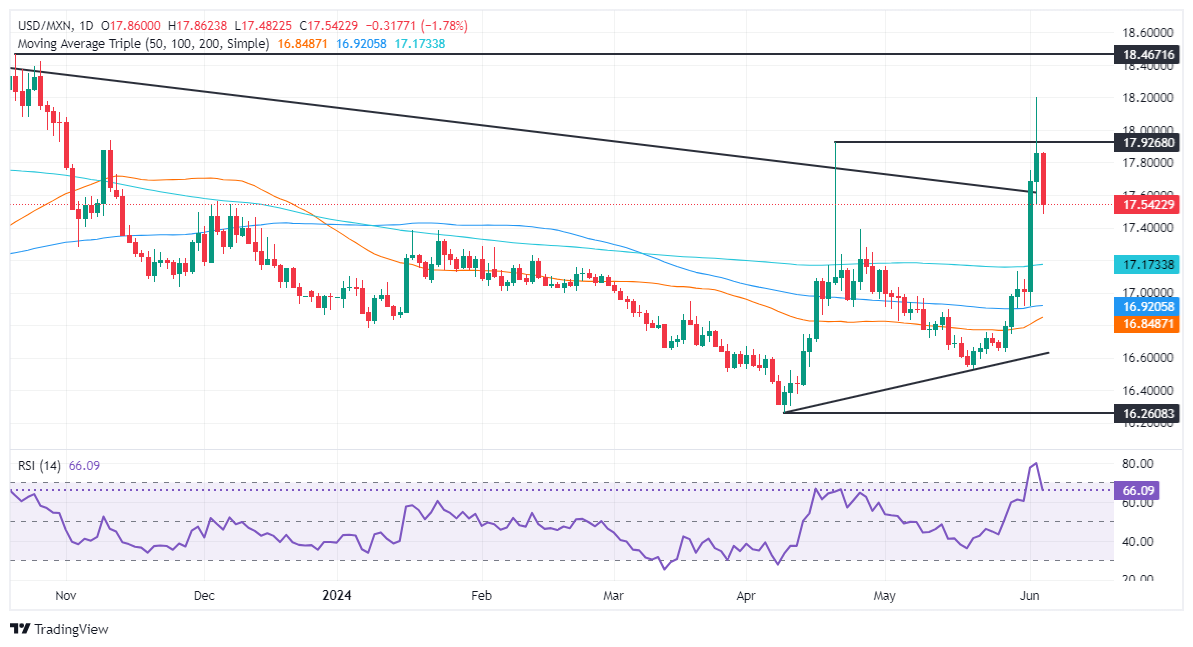Most recent article: Mexican Peso claws back losses from election fallout
- Mexican Peso gains over 1.50% Wednesday after peaking at 17.85 earlier.
- Finance Minister Rogelio Ramirez de la O reassures markets about financial discipline and investment facilitation.
- US economic data was mixed as ADP employment figures disappoint, while ISM Services PMI exceeds estimates.
The Mexican Peso stages a recovery against the US Dollar, printing gains of more than 1.50% on Wednesday following Mexican Finance Minister Rogelio Ramirez de la O’s press conference on Tuesday that attempted to calm the financial markets.
Although data from Mexico and the United States would warrant further upside, the pair seems to have stabilized after two days of volatile sessions following Sunday’s presidential election that saw Dr. Claudia Sheinbaum lead the ruling Morena party to victory. The USD/MXN trades at 17.54 after hitting a daily high of 17.85.
“We want to confirm to international organizations and private investors that our project is based on financial discipline, abiding by the autonomy of the Bank of Mexico, adherence to the rule of law and facilitating national and foreign private investment,” said Ramirez de la O, according to a translation by El Financiero.
Some analysts considered his message vague, and doubts continue to cloud Dr. Claudia Sheinbaum’s upcoming presidency due to the strong majority of the Morena party.
USD/MXN traders ditched the emerging market currency because they feared Morena’s overwhelming victory in Congress could threaten to eliminate autonomous regulators like the National Elections Institute and push a bill for direct election of Supreme Court judges.
Meanwhile, Mexico’s economic docket revealed that consumer confidence deteriorated further in May than in April.
Across the border, US employment figure estimates in the ADP Employment Change report came below estimates, reaffirming that the US labor market is cooling. However, May's latest ISM Services PMI figures exceeded estimates and expanded sharply, boosting appetite for the Greenback.
Daily digest market movers: Mexican Peso shrugs off election fears and advances
- Mexican Consumer Confidence fell to a seven-month low of 46.7 in May, below April’s 47.7.
- September would be a crucial month for the Mexican Congress. Morena’s majority could push bills blocked by the opposition, including the reduction of lawmakers and plans for direct election of the Supreme Court members.
- Morgan Stanley noted that if Mexico’s upcoming government and Congress adopted an unorthodox agenda, it would undermine Mexican institutions and be bearish for the Mexican Peso, which could weaken to 19.20.
- Speculation of another Banxico rate cut in June could pave the way for further upside in the USD/MXN.
- Institute for Supply Management (ISM) revealed that business activity in the US service sector expanded. The ISM Services PMI was 53.8 in May, the highest reading since August 2023, surpassing the 50.8 projected by the consensus and April’s 49.4 contraction.
- The US ADP National Employment Change in May missed the estimates of 175K and came in at 152K, lower than April’s 188K.
- Alongside a softer April JOLTS report, ADP data hints that jobs market is cooling ahead of the release of May Nonfarm Payrolls data on Friday.
- The futures market suggests the Federal Reserve might cut rates by 35 basis points in 2024, according to the December 2024 fed funds future rate contract.
Technical analysis: Mexican Peso counterattacks as USD/MXN slides below 17.60
The USD/MXN shifts to neutral bias despite posting losses close to 1.80% on Wednesday. However, Monday’s Japanese Marabuzo candlestick suggests that buyers are in charge and that the exotic pair might head back to levels below the already broken 200-day Displaced Moving Average (DMA) near 17.16.
The USD/MXN’s first resistance level would be the June 3 high at 17.74, followed by the 18.00 psychological level. Once surpassed, the next stop would be the year-to-date high of 18.19.
Momentum favors further upside as the Relative Strength Index (RSI) sits at the higher end of the graph. But RSI’s exiting from overbought conditions opened the door for a pullback toward the current day’s low of 17.48.
In the event of further losses, the next support would be the 200-DMA at 17.16, followed by the 17.00 figure, ahead of the 100-day DMA at 16.91. Once cleared, up next would be the 50-day DMA at 16.84.
Mexican Peso FAQs
The Mexican Peso (MXN) is the most traded currency among its Latin American peers. Its value is broadly determined by the performance of the Mexican economy, the country’s central bank’s policy, the amount of foreign investment in the country and even the levels of remittances sent by Mexicans who live abroad, particularly in the United States. Geopolitical trends can also move MXN: for example, the process of nearshoring – or the decision by some firms to relocate manufacturing capacity and supply chains closer to their home countries – is also seen as a catalyst for the Mexican currency as the country is considered a key manufacturing hub in the American continent. Another catalyst for MXN is Oil prices as Mexico is a key exporter of the commodity.
The main objective of Mexico’s central bank, also known as Banxico, is to maintain inflation at low and stable levels (at or close to its target of 3%, the midpoint in a tolerance band of between 2% and 4%). To this end, the bank sets an appropriate level of interest rates. When inflation is too high, Banxico will attempt to tame it by raising interest rates, making it more expensive for households and businesses to borrow money, thus cooling demand and the overall economy. Higher interest rates are generally positive for the Mexican Peso (MXN) as they lead to higher yields, making the country a more attractive place for investors. On the contrary, lower interest rates tend to weaken MXN.
Macroeconomic data releases are key to assess the state of the economy and can have an impact on the Mexican Peso (MXN) valuation. A strong Mexican economy, based on high economic growth, low unemployment and high confidence is good for MXN. Not only does it attract more foreign investment but it may encourage the Bank of Mexico (Banxico) to increase interest rates, particularly if this strength comes together with elevated inflation. However, if economic data is weak, MXN is likely to depreciate.
As an emerging-market currency, the Mexican Peso (MXN) tends to strive during risk-on periods, or when investors perceive that broader market risks are low and thus are eager to engage with investments that carry a higher risk. Conversely, MXN tends to weaken at times of market turbulence or economic uncertainty as investors tend to sell higher-risk assets and flee to the more-stable safe havens.
Information on these pages contains forward-looking statements that involve risks and uncertainties. Markets and instruments profiled on this page are for informational purposes only and should not in any way come across as a recommendation to buy or sell in these assets. You should do your own thorough research before making any investment decisions. FXStreet does not in any way guarantee that this information is free from mistakes, errors, or material misstatements. It also does not guarantee that this information is of a timely nature. Investing in Open Markets involves a great deal of risk, including the loss of all or a portion of your investment, as well as emotional distress. All risks, losses and costs associated with investing, including total loss of principal, are your responsibility. The views and opinions expressed in this article are those of the authors and do not necessarily reflect the official policy or position of FXStreet nor its advertisers. The author will not be held responsible for information that is found at the end of links posted on this page.
If not otherwise explicitly mentioned in the body of the article, at the time of writing, the author has no position in any stock mentioned in this article and no business relationship with any company mentioned. The author has not received compensation for writing this article, other than from FXStreet.
FXStreet and the author do not provide personalized recommendations. The author makes no representations as to the accuracy, completeness, or suitability of this information. FXStreet and the author will not be liable for any errors, omissions or any losses, injuries or damages arising from this information and its display or use. Errors and omissions excepted.
The author and FXStreet are not registered investment advisors and nothing in this article is intended to be investment advice.
Recommended content
Editors’ Picks
AUD/USD: No changes to the range bound theme

Once again, AUD/USD navigated a vacillating session and ended around the 06650 zone despite the corrective retracement in the Greenback ahead of the release of key US PCE data.
EUR/USD: Bulls remained unconvinced

EUR/USD set aside part of the recent bearishness and revisited the area above the 1.0700 barrier, although that bullish attempt appears to have lacked conviction in spite of the broad-based correction in the US Dollar.
Gold back to its comfort zone around $2,330

Gold bounces off the psychologically important $2,300 level and trades above $2,320 on Thursday. The benchmark 10-year US Treasury bond yield stays in negative territory following latest US data, allowing XAU/USD to extend its rebound.
Ethereum on-chain metrics point to potential rally

Ethereum (ETH) is up nearly 3% on Thursday as upcoming spot ETH ETF launch and key on-chain metrics suggest an ETH rally might be around the corner.
The Federal Reserve is bleeding red ink and you're on the hook

The Federal Reserve is losing over $1 billion every week and you're on the hook. Since September 2022, the central bank has reported losses of around $176.4 billion.
